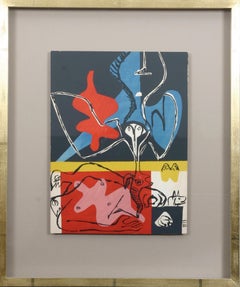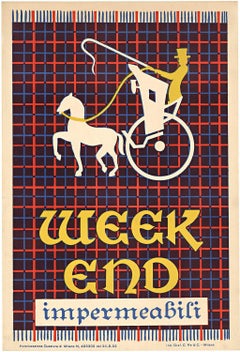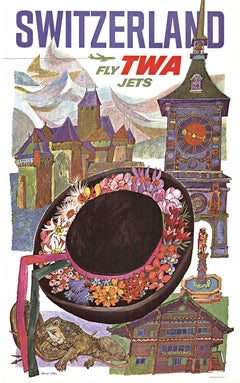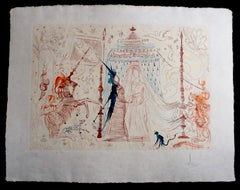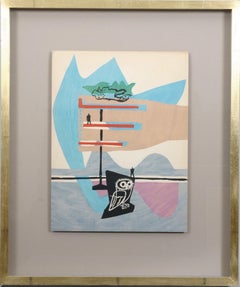More Prints
to
475
647
558
345
145
100
Overall Width
to
Overall Height
to
693
311
183
61
44
25
25
19
5
4
4
3
169
156
130
52
47
245
512
4,483
3,038
28
54
70
117
230
345
896
1,023
566
364
179
1,453
314
21
91
58
54
53
31
31
27
26
26
18
16
13
8
8
6
6
6
5
5
5
1,138
215
173
85
65
147
471
1,016
671
More Prints For Sale
Period: Mid-20th Century
Period: Early 1900s
Le Corbusier: "Le Poème de L'Angle Droit". Original lithograph.
By Le Corbusier
Located in Richmond, GB
Charles-Éduard Jeanneret, known as Le Corbusier, was a Swiss architect and designer who is generally regarded as a key figure in the development of modern architecture, his work bein...
Category
Mid-20th Century Modern More Prints
Materials
Lithograph
Original Week End Impermeabili vintage Italian poster
Located in Spokane, WA
Original Week End Impermeabili Italian vintage fashion poster. Archival linen backed in fine condition, ready to frame. Grade A condition. Printed by Ind. Graf. C. Re & C. Milano, Italy. 1952.
A small company produced vintage posters for their company in limited or small quantities. Only a few of these Italian vintage posters...
Category
1950s Italian School More Prints
Materials
Lithograph
$500 Sale Price
20% Off
Original 'Switzerland, Fly TWA Jets' vintage travel poster David Klein
By David Klein
Located in Spokane, WA
Original vintage poster: SWITZERLAND FLY TWA Trans World Airline. Artist:l David Klein. Archival linen backed in fine condition. Artist: David Klein #Da...
Category
1960s More Prints
Materials
Offset
Gala, mon seul désir
Located in Hollywood, FL
ARTIST: Salvador Dali
TITLE: Gala, mon seul desir
MEDIUM: Etching
SIGNED: Hand Signed
PUBLISHER: Jean Schneider, Basel/Bergruen, Paris
EDITION NUMBER: XLVII/LXXV
MEASUREMENTS:...
Category
1960s Surrealist More Prints
Materials
Etching
Original "Fireball 500" movie insert vintage poster 1966
Located in Spokane, WA
Original, archival linen backed, vintage movie poster: FIREBALL 500.
Fireball 500, 1966. Original antique muscle car hot rod movie poster for sale, ...
Category
1960s American Modern More Prints
Materials
Lithograph
Le Corbusier: "Le Poème de L'Angle Droit". Original lithograph.
By Le Corbusier
Located in Richmond, GB
Charles-Éduard Jeanneret, known as Le Corbusier, was a Swiss architect and designer who is generally regarded as a key figure in the development of modern architecture, his work bein...
Category
Mid-20th Century Modern More Prints
Materials
Lithograph
Paolozzi Signed 1969 poster Galerie Mikro vintage futuristic psychedelic pop art
Located in New York, NY
Printed in chartreuse, dark green, bright yellow, orange, and brown, this surreal scene features a grey-walled room populated with strange machinery and a red chair. Paolozzi creates...
Category
1960s Pop Art More Prints
Materials
Offset
Atelier Mourlot Bank Street by Joan Miro - colorful abstract original lithograph
By Joan Miró
Located in New York, NY
This colorful abstract original lithograph was printed in 1967 at the Atelier Mourlot in NYC. When The Mourlot Studio decided to open a branch in New York City, after a successful ex...
Category
1960s Abstract Expressionist More Prints
Materials
Lithograph
Composition - Lithograph by Ossip Zadkine - mid-20th Century
Located in Roma, IT
Composition is a lithograph, realized by Ossip Zadkine
Stamped in the lower right.
Numbered, edition 37/65
Good conditions
The artwork represents an abstract composition through...
Category
Mid-20th Century Cubist More Prints
Materials
Lithograph
Air France Europe original vintage travel poster
Located in Spokane, WA
Original AIR FRANCE EUROPE, Editions Perceval, artist: Jacques Nathan Garamond. Professional acid-free archival linen backed vintage travel post...
Category
1960s Expressionist More Prints
Materials
Lithograph
Original 1966 Santa Barbara Sports Car Races Championship vintage poster
Located in Spokane, WA
Rare, original, linen-backed SANTA BARBARA Championship Sports Car Races. . (May 28-29, 1966 - Santa Barbara, California. Excellent condition original California racing poster....
Category
1960s American Modern More Prints
Materials
Offset
$740 Sale Price
20% Off
Russian Aircraft Identification Poster World War II Allied aeroplanes
Located in London, GB
To see our other original vintage warbird aeroplane posters, photographs and paintings, scroll down to "More from this Seller" and below it click on "See all from this Seller".
Russian Aircraft...
Category
1940s Modern More Prints
Materials
Lithograph
Salvador Dali, "Grenade et l'ange from FlorDali - Les Fruits"
Located in Chatsworth, CA
This piece was created in 1969 by Salvador Dali, it is a photolithograph of a original gouache painted on printed illustrations with original engraving was created in 1969 by Salvado...
Category
1960s Surrealist More Prints
Materials
Lithograph
Cherub Super Limen Domus - Lithograph - 1964
Located in Roma, IT
Cherub Super Limen Domus is Color lithograph on heavy rag paper realized in 1964. It is part of Biblia Sacra vulgatæ edition is published by Rizzoli-Mediolani between 1967 and 1969.
...
Category
1960s Surrealist More Prints
Materials
Lithograph
$484 Sale Price
25% Off
1939 Original Keep Calm and Carry On Poster
Located in London, GB
Anonymous, UK 1939
Keep Calm and Carry On
Ministry of Information
Lithographic poster
75 x 50 cm
Very rare - we have traced copies in the Imperial War Museum collection but no other...
Category
1930s Modern More Prints
Materials
Lithograph
Le Corbusier: "Le Poème de L'Angle Droit". Original lithograph.
By Le Corbusier
Located in Richmond, GB
Charles-Éduard Jeanneret, known as Le Corbusier, was a Swiss architect and designer who is generally regarded as a key figure in the development of modern architecture, his work bein...
Category
Mid-20th Century Modern More Prints
Materials
Lithograph
L'Air
By Joan Miró
Located in OPOLE, PL
Joan Miro (1893-1983) - L'Air
Lithograph from 1937.
Dimensions of work: 35 x 26 cm
Publisher: Tériade, Paris.
The work is in Excellent condition.
Fast and secure shipment.
Category
1930s Surrealist More Prints
Materials
Lithograph
$1,711 Sale Price
20% Off
La Ruse de Dorcon, from Daphnis et Chloé
By Marc Chagall
Located in OPOLE, PL
Marc Chagall (1887-1985) - La Ruse de Dorcon, from Daphnis et Chloé
Lithograph from 1961.
The edition of 59/60 with wide margins.
Dimensions of work: 53.7 x 37.8 cm.
Hand signed....
Category
1960s Symbolist More Prints
Materials
Lithograph
$14,345 Sale Price
20% Off
Plate 7, from Derriere Le Miroir #141 (Stabiles)
Located in Washington, DC
Artist: Alexander Calder
Title: Plate 7
Portfolio: Derriere Le Miroir #141 (Stabiles)
Medium: Lithograph
Date: 1963
Edition: Unnumbered
Sheet Size: 15" x 22"
Image Size: 15" x 22"
Si...
Category
1960s Abstract More Prints
Materials
Lithograph
Signs
Located in New York, NY
A very good impression of this scarce color screenprint on white wove paper. Signed, dated and numbered 44/75 in pencil. Published by Marlborough Graphics, Inc., New York.
Category
1960s Abstract Expressionist More Prints
Materials
Color, Screen
Leamington Spa original vintage British travel poster
Located in Spokane, WA
Original vintage travel poster: Leamington Spa. Art Deco British travel poster created by the artist Freda Lingstrom. This poster is archival line...
Category
Mid-20th Century Art Deco More Prints
Materials
Lithograph
Colorful Russian French Judaica Jewish Shtetl Wedding Lithograph Mourlot Paris
By Mane Katz
Located in Surfside, FL
Mane-Katz (1894-1962) Original Lithograph published by Andre Sauret, Monte Carlo, 1966, printed in France, by Mourlot. The ouvrage sheet is not included. this is from a limited editi...
Category
1960s Modern More Prints
Materials
Lithograph
Cirque
By Marc Chagall
Located in OPOLE, PL
Marc Chagall (1887-1985) - Cirque
Lithograph from 1967.
The edition of 250 on Arches paper.
Dimensions of work: 42 x 32.5 cm.
Publisher: Tériade, Paris.
Reference: Mourlot 487, ...
Category
1930s Symbolist More Prints
Materials
Lithograph
$1,864
Tanks #1.
Located in New York, NY
This 1929 lithograph by Louis Lozowick was printed in an edition of 50. Lozowick signed this impression in pencil lower right with a monogram on stone, in the lower left. The sheet...
Category
Mid-20th Century Modern More Prints
Materials
Lithograph
FlorDali/Les Fruits Pear
Located in Hollywood, FL
ARTIST: Salvador Dali
TITLE: FlorDali/Les Fruits Pear
MEDIUM: Etching
SIGNED: Hand Signed
PUBLISHER: Jean Schneider, Basel
EDITION NUMBER: 48/200
MEASUREMENTS: 29.75" x 21.75...
Category
1960s Surrealist More Prints
Materials
Etching
Nature morte à la pipe
Located in OPOLE, PL
Pablo Picasso (1881-1973) - Nature morte à la pipe
Lithograph, pochoir from 1962.
An unnumbered copy from a limited edition of 264.
Dimensions of work: 36 x 48.5 cm
Publisher: Le...
Category
1960s Modern More Prints
Materials
Lithograph
View of Venice I - San Giorgio
Located in New York, NY
Antonio Frasconi created the color woodcut entitled "View of Venice I – San Giorgio" in 1968. It is signed, titled, dated, and inscribed “17/20” in pencil. The paper size is 24 x 36 ...
Category
1960s American Modern More Prints
Materials
Woodcut
Henri Matisse - Fruits - Original Lithograph
Located in Collonge Bellerive, Geneve, CH
Henri Matisse - Fruits - Original Lithograph
1964
Dimensions: 30 x 20 cm
Edition of 200 (one of the 200 on Vélin de Rives)
Mourlot Press, 1964
Unsigned and unumbered as issued
Category
1960s Modern More Prints
Materials
Lithograph
The Paradise, Canto 14 - Apparition du Christ
Located in OPOLE, PL
Salvador Dali (1904-1989) - The Paradise, Canto 14 - Apparition du Christ
Woodcut print from 1960.
Dimensions of work: 33 x 26.2 cm
Publisher: Les Heures Claires, Paris.
The work...
Category
1960s Surrealist More Prints
Materials
Lithograph
$860 Sale Price
20% Off
Waves (Derriere le Miroir #156)
Located in Washington, DC
Artist: Alexander Calder
Title: Waves (Derriere le Miroir 156)
Portfolio: Derriere le Miroir #156
Medium: Lithograph
Date: 1966
Edition: Unnumbered
Frame Size: 21 1/4" x 17 1/4"
Shee...
Category
1960s Abstract More Prints
Materials
Lithograph
Automotive design for Alexis Kellner AG Berlin
Located in London, GB
Half-Limousine coachwork design for an Austro-Daimler.
Gouache and watercolour heightened with gum-arabic on very dark green card, annotated in pale ink with body type below, numbere...
Category
1930s Modern More Prints
Materials
Watercolor, Gouache, Handmade Paper
Escultor y escultura
Located in OPOLE, PL
Pablo Picasso (1881-1973) - Escultor y escultura
Etching from 1965.
Edition of 255.
Dimensions of work: 48 x 38 cm.
Imprimée à Mougins.
Référence : Bloch 1187; Baer 1156.
The w...
Category
1950s Modern More Prints
Materials
Lithograph
$1,434 Sale Price
20% Off
Stabisme Pastoral
By Asger Jorn
Located in OPOLE, PL
Asger Jorn (1914-1973) - Stabisme Pastoral
Lithograph from 1968.
Dimensions of work: 45 x 32 cm
Printed by Clot, Bramsen and Georges, Paris
The work is in Excellent condition.
F...
Category
1960s Surrealist More Prints
Materials
Lithograph
Rythme-couleur - Hand-signed and numbered original lithograph, 1962
Located in New York, NY
Sonia Delaunay
Rythme-couleur, 1962
Lithograph on Fabriano wove paper
27 3/5 × 19 7/10 in l 70.2 × 50 cm
Frame included - 32 1/3 x 24 4/5 l 83 x 63 cm
Edition of 40
Condition: Overa...
Category
1960s Abstract Geometric More Prints
Materials
Lithograph
Oval Head of a Woman with Piercing Eyes (Plate XXI), from Carmen
Located in Washington, DC
Artist: Pablo Picasso
Title: Oval Head of a Woman with Piercing Eyes (Plate XXI)
Portfolio: Carmen
Medium: Etching on Montval wove paper
Year: 1949
Edition: 289
Frame Size: 21" x 18"...
Category
1940s Cubist More Prints
Materials
Etching
La Piscine I
Located in Washington, DC
Artist: Henri Matisse (after)
Title: La Piscine I
Portfolio: The Last Works of Henri Matisse
Medium: Lithograph
Date: 1958
Edition: 2000
Sheet Size: 14" x 42"
Signature: Unsigned
Ref...
Category
1950s Abstract More Prints
Materials
Lithograph
De Mauvais Sujets - Planche V
By Marc Chagall
Located in OPOLE, PL
Marc Chagall (1887-1985) - De Mauvais Sujets - Planche V
Etching and aquatint from 1958.
An unnumbered and unsigned copy from a limited edition of 153.
Dimensions of sheet: 43.5 x 32.5 cm
Dimensions in frame: 63.2 x 53.2 cm
Publisher: Les Bibliophiles de l’Union Française, Paris.
Printer: Atelier Lacourière et Frélaut, Paris.
Reference: Cramer 35
--
This original color etching comes from De Mauvais Sujets ("The Bad Subjects"), a 1958 illustrated portfolio that paired Marc Chagall’s artwork...
Category
1950s Surrealist More Prints
Materials
Etching, Aquatint
Litografía original III
By Joan Miró
Located in OPOLE, PL
Joan Miro (1893-1983) - Litografía original III
Lithograph from 1972.
Dimensions of work: 32 x 24.5 cm.
Dimensions in frame: 52 x42 cm.
Publisher: Maeght Éditeur, Paris.
Printed ...
Category
1930s Surrealist More Prints
Materials
Lithograph
San Francisco. 'Seagull over Golden Gate Bridge, 1950s'. Book & Signed Print
By Fred Lyon
Located in Los Angeles, CA
An epic pictorial history of the City by the Bay
Starting with an early picture of a gang of badass gold prospectors who put this beautiful Northern California city on the map, this ambitious and immersive photographic history of San Francisco takes a winding tour through the city from the mid–nineteeth century to the present day.
Enjoy eye-catching views of the city’s most enduring landmarks and symbols: the Golden Gate Bridge, Chinatown, the picturesque trams that wind up and down the famously steep hills, the popular waterfront, its beautiful bay, and its spectacular cityscapes and vistas. San Francisco’s counterculture movements that shaped our collective consciousness are also featured prominently: the beats of North Beach, the hippies of Haight-Ashbury, the gay communities of Castro, and the Black Panthers of neighboring Oakland. Some of the city’s most famous residents also make appearances: Robin Williams, The Grateful Dead, Angela Davis...
Category
Mid-20th Century More Prints
Materials
Archival Paper, Digital, Digital Pigment
Oracle: Study for Clairvoyant
Located in New York, NY
Seymour Lipton
Oracle: Study for Clairvoyant, 1969
Lithograph on wove paper
24 1/2 × 18 inches
Pencil signed "Lipton" lower right recto Pencil numbered 44/100, lower left recto pencil titled and dated, verso
Unframed
Uncommon mid century modern pencil signed and numbered lithograph by renowned abstract expressionist sculptor Seymour Lipton. "Study for Clairvoyant", also known as "Oracle", is a study for a famous monumental modernist masterpiece by Lipton. Other editions of this lithograph are in major collections such as that of the Brooklyn Museum. Rarely to market.
Provenance: Swann Galleries
Category
1960s Abstract Expressionist More Prints
Materials
Lithograph
Ego Sum Deus Tuus - Lithograph - 1964
Located in Roma, IT
Ego Sum Deus Tuus is a Color lithograph on heavy rag paper realized in 1964. It is part of Biblia Sacra vulgatæ edition is published by Rizzoli-Mediolani between 1967 and 1969.
Sig...
Category
1960s Surrealist More Prints
Materials
Lithograph
$493 Sale Price
25% Off
Jean Cocteau - Bulls - Original Lithograph
By Jean Cocteau
Located in Collonge Bellerive, Geneve, CH
Original Lithograph by Jean Cocteau
Title: Taureaux
Signed in the plate
Dimensions: 40 x 30 cm
Edition: 200
Luxury print edition from the portfolio of Trinckvel
1965
Jean Cocteau
W...
Category
1960s Modern More Prints
Materials
Lithograph
Ex Aegypto Vocavi Filium Meum - Lithograph - 1964
Located in Roma, IT
Ex Aegypto Vocavi Filium Meum is a Color lithograph on heavy rag paper realized in 1964. It is part of Biblia Sacra vulgatæ edition is published by Rizzoli-Mediolani between 1967 and...
Category
1960s Surrealist More Prints
Materials
Lithograph
$484 Sale Price
25% Off
La Foundation Marguerite et Aime Maeght
By Joan Miró
Located in Washington, DC
Artist: Joan Miro
Title: La Foundation Marguerite et Aime Maeght
Medium: Lithograph
Date: 1964
Edition: Unnumbered
Frame Size: 21 1/4" x 17 1/4"
Sheet Size...
Category
1960s More Prints
Materials
Lithograph
Vitrail de l’église de Saint Dominique (after) Georges Braque, 1960
Located in New York, NY
This lithograph was printed in 1960 and is based on the glassworks of the Saint Dominique church in Varengeville, in Normandy, where Braque had his country house. The original gouach...
Category
1960s Modern More Prints
Materials
Lithograph
Colorful Russian French Judaica Jewish Shtetl Wedding Lithograph Mourlot Paris
By Mane Katz
Located in Surfside, FL
Mane-Katz (1894-1962) Original Lithograph published by Andre Sauret, Monte Carlo, 1966, printed in France, by Mourlot. The ouvrage sheet is not included. this is from a limited editi...
Category
1960s Modern More Prints
Materials
Lithograph
De mémoir d'homme, Planche V
Located in OPOLE, PL
Pablo Picasso (1881-1973) - De mémoir d'homme, Planche V
Lithograph from 1950.
An unnumbered copy from a limited edition of 350.
Dimensions of work: 32 x 25 cm
Publisher: Édition...
Category
1950s Modern More Prints
Materials
Lithograph
New York City Opera
Located in New York, NY
Richard Anuszkiewicz
New York City Opera, 1968
Silkscreen poster
35 x 25 inches
Unsigned
Anuszkiewicz created this poster, which was part of "Seve...
Category
1960s Op Art More Prints
Materials
Screen
Cubist Portrait
Located in OPOLE, PL
Georges Braque (1882-1963) - Cubist Portrait
Lithograph from 1939.
Dimensions of work: 35 x 26 cm
Publisher: Tériade, Paris.
The work is in Excellent condition.
Fast and secure ...
Category
1930s Surrealist More Prints
Materials
Lithograph
Square Head of a Man with Clenched Mouth (Plate IX), from Carmen
Located in Washington, DC
Artist: Pablo Picasso
Title: Square Head of a Man with Clenched Mouth (Plate IX)
Portfolio: Carmen
Medium: Etching on Montval wove paper
Year: 1949
Edition: 289
Frame Size: 21" x 18"...
Category
1940s More Prints
Materials
Etching
Suckers State I
Located in New York, NY
A very good impression of this lithograph on Rives BFK. Signed, inscribed "state I" and numbered 111/150 in pencil. Printed and published by Gemini G.E.L., Los Angeles, with the blin...
Category
1960s Pop Art More Prints
Materials
Lithograph
Untitled - Original Lithograph by Eugenio Miccini - 1964
Located in Roma, IT
Hand signed and dated. Artist's proof.
Very good conditions.
Category
1960s Contemporary More Prints
Materials
Lithograph
$215 Sale Price
25% Off
Common and Surf Scoter, French antique bird duck art illustration print
By P. Mahler
Located in Melbourne, Victoria
'Macreuse Noire - Macreuse a Lunettes'
(Common Scoter and Surf Scoter)
French chromolithograph, published in 1931. Printed title lower right of sheet. Plate number top right. From ...
Category
1930s Art Deco More Prints
Materials
Lithograph
Untitled - Original Lithograph by Enrico Prampolini - 1954 ca.
Located in Roma, IT
Edition of 100 prints, numbered and hand signed.
Good conditions.
A nice and rare graphic work, probably one of the last ones, by a key figure of Futurism.
This artwork is shipped f...
Category
1950s Futurist More Prints
Materials
Lithograph
Horse-1 - Rare Original Lithograph - 1948
Located in Roma, IT
This work is one of the lithographs for the magazine "L'Immagine", 1950.
Editions consist in 50 copies numbered from 1 to 30 and from I to XX, and some artist's test. (P.A.)
Publishe...
Category
1940s More Prints
Materials
Lithograph
$1,524 Sale Price
25% Off
Vigne
Located in OPOLE, PL
Henri Matisse (1869-1954) - Vigne
Lithograph from 1958.
Dimensions of work: 35.5 x 26.4 cm
Publisher: Tériade, Paris.
First, original edition.
The work is in Excellent condition.
Category
1950s Surrealist More Prints
Materials
Lithograph
Adam and Eve are Banished from Paradise
By Marc Chagall
Located in Washington, DC
Artist: Marc Chagall
Title: Adam and Eve are Banished from Paradise
Portfolio: Drawings for the Bible
Medium: Lithograph
Year: 1960
Edition: Unnumbered
Sheet Size: 14 3/8" x 10 1/4"
...
Category
1960s More Prints
Materials
Lithograph
La Comédie Humaine
Located in OPOLE, PL
Pablo Picasso (1881-1973) - La Comédie Humaine
Lithograph from 1954.
Dimensions of work: 35.5 x 26.5 cm
Publisher: Tériade, Paris.
The work is in Excellent condition.
Fast and s...
Category
1950s Modern More Prints
Materials
Lithograph
Bateau
Located in OPOLE, PL
Henri Matisse (1869-1954) - Bateau
Lithograph from 1958.
Dimensions of work: 35.5 x 26.4 cm
Publisher: Tériade, Paris.
First, original edition.
The work is in Good condition.
-...
Category
1950s Surrealist More Prints
Materials
Lithograph
Blue Still Life
By Marc Chagall
Located in Washington, DC
Artist: Marc Chagall
Title: Blue Still Life
Portfolio: Derriere le Miroir 99-100
Medium: Lithograph
Date: 1957
Edition: 2500
Frame Size: 19 1/2" x 17 3/4"
Sheet Size: 15" x 11"
Signa...
Category
1950s Modern More Prints
Materials
Lithograph
